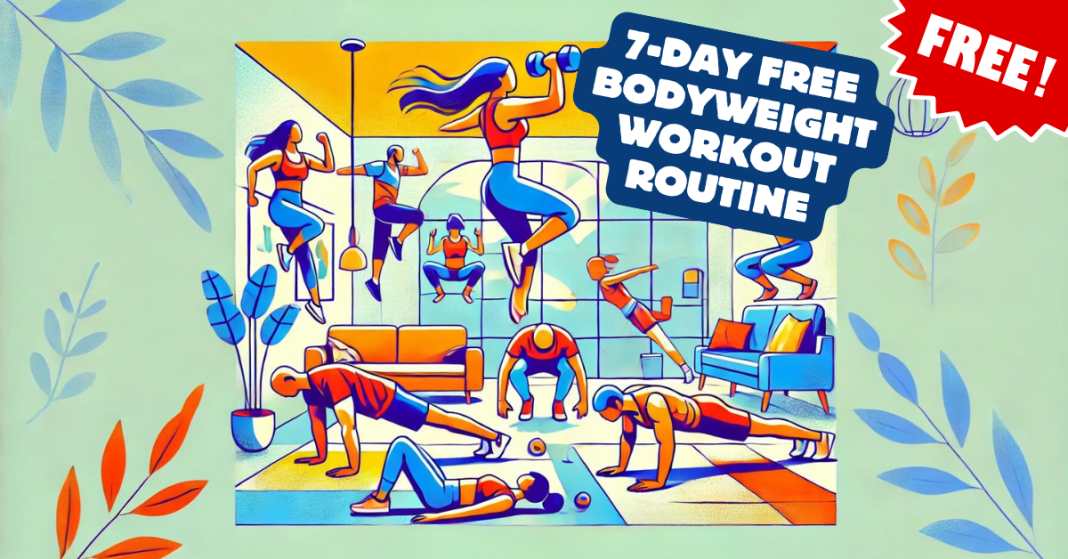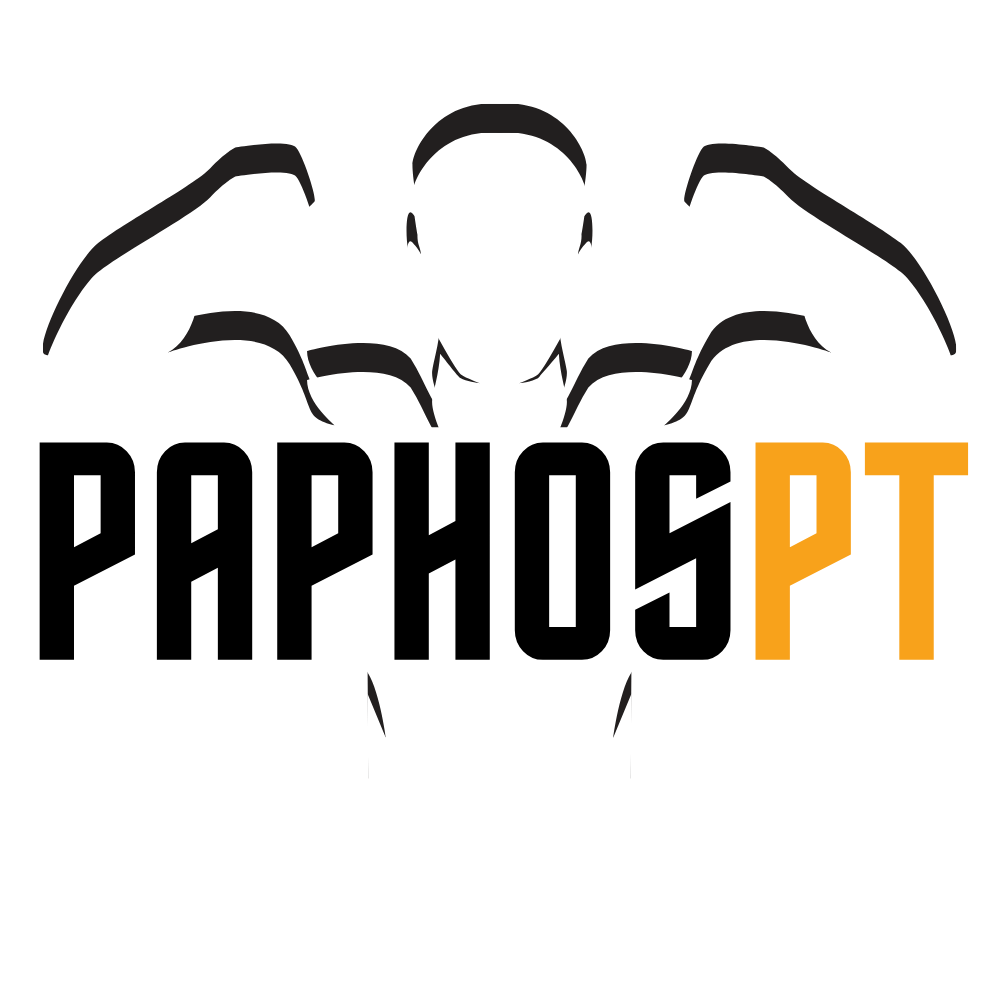Table of Contents
In today’s fast-paced world, finding time for fitness can be challenging. Many people struggle to balance work, personal life, and their health goals. The good news is that you don’t need a gym membership or expensive equipment to stay fit and healthy. With a well-structured 7-Day Free Bodyweight Workout Routine, you can target all major muscle groups, improve your conditioning, and boost your overall fitness—all from the comfort of your home. This routine is designed to be accessible for everyone, regardless of fitness level, and focuses on compound movements, which engage multiple muscle groups at once. Best of all, it’s completely equipment-free!
This 7-Day Free Bodyweight Workout Routine is split into seven days of targeted exercises, ensuring that you hit every muscle group at least three times per week while incorporating cardio for conditioning. Whether you’re a beginner or more advanced, you can adjust the repetitions and sets based on your fitness level. Let’s break down each day and its exercises, so you can get started on your path to a fitter, stronger you.
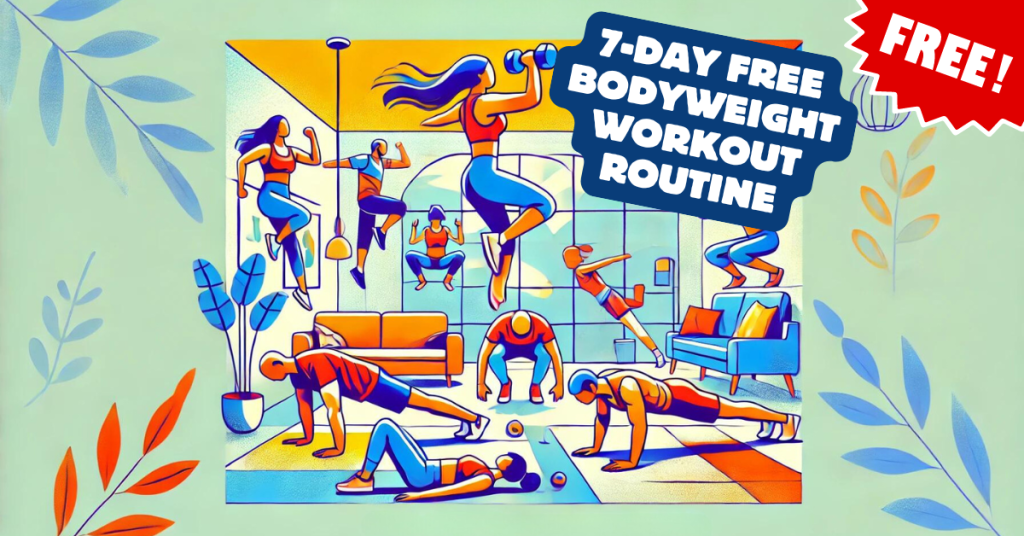
Why Choose a Bodyweight Workout Routine?
Before diving into the details of the routine, it’s important to understand why bodyweight workouts are so effective. These workouts offer several benefits:
- No Equipment Needed: The primary benefit of bodyweight workouts is that they require no gym equipment. All you need is a little space and your own body weight.
- Full-Body Engagement: Compound exercises in bodyweight workouts target multiple muscle groups simultaneously, making them more efficient.
- Convenience: You can perform these workouts anywhere—at home, in a park, or while traveling. The routine is flexible and adaptable to your schedule.
- Functional Strength: Bodyweight exercises help you build functional strength that translates to everyday activities, improving balance, coordination, and flexibility.
Now that you know why this approach is effective, let’s explore the 7-Day Free Bodyweight Workout Routine in detail.
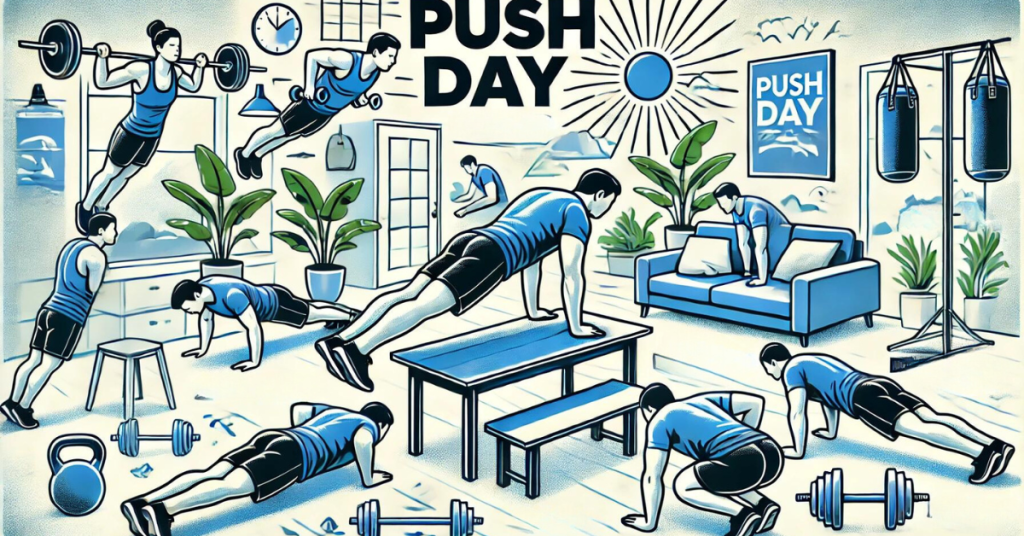
Weekly Workout Schedule: 7 Days of Focused Training
Day 1 & Day 5: Push Day
Push days are all about working the muscles responsible for pushing movements, primarily targeting your chest, shoulders, and triceps. The exercises in this routine are designed to strengthen these muscles while also building endurance.
Warm-up (5-10 minutes)
- Jumping jacks
- Arm circles
- Dynamic stretches (focusing on your shoulders and chest)
Workout:
- Push-ups (standard or decline): 4 sets of 12-15 reps
Push-ups are a classic exercise for strengthening the chest, shoulders, and triceps. If you’re more advanced, try decline push-ups by placing your feet on an elevated surface. - Pike Push-ups (for shoulders): 4 sets of 10-12 reps
This exercise places more emphasis on the shoulders, giving them a targeted workout. - Triceps Dips (using a chair or elevated surface): 4 sets of 12-15 reps
Dips are an excellent way to focus on your triceps, with the added benefit of engaging your shoulders and core. - Wide Push-ups (for chest emphasis): 3 sets of 12-15 reps
By widening your hand placement, this variation of push-ups places more emphasis on the chest. - Plank-to-Push-Up (chest + triceps): 3 sets of 10-12 reps
This combination exercise strengthens your chest, triceps, and core while improving shoulder stability. - Diamond Push-ups (for triceps): 3 sets of 8-10 reps
Diamond push-ups are a more advanced move that primarily targets the triceps but also works the chest and shoulders.
Finisher:
- Burpees: 3 sets of 12-15 reps
Burpees are a full-body exercise that increases heart rate while engaging the chest, shoulders, and legs. They’re an excellent way to finish a push workout with a cardio boost.
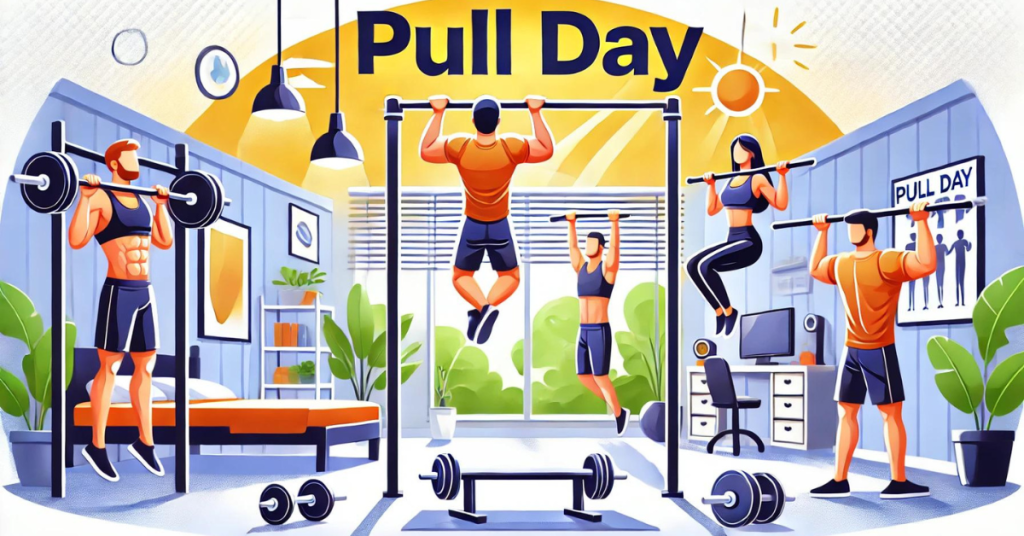
Day 2 & Day 6: Pull Day
Pull days focus on strengthening the muscles involved in pulling movements, primarily targeting your back and biceps. These exercises will help improve posture and build upper-body strength.
Warm-up (5-10 minutes):
- Jump rope or shadow boxing
- Dynamic stretches for back and shoulders
Workout:
- Pull-ups (or Inverted Rows using a sturdy surface): 4 sets of 8-12 reps
Pull-ups are the ultimate bodyweight exercise for building back and bicep strength. If you don’t have access to a pull-up bar, you can perform inverted rows using a sturdy surface like a table or railing. - Chin-ups (underhand grip): 4 sets of 8-12 reps
Chin-ups are a variation of pull-ups that place more emphasis on the biceps while still engaging the back muscles. - Superman Hold (for back and core): 4 sets of 20-30 second holds
This static exercise targets the lower back, glutes, and core, helping to strengthen these areas while improving stability. - Towel Rows (using a towel looped over a door or pole): 4 sets of 10-12 reps
Towel rows are a great substitute for equipment-based rowing exercises, targeting the upper back and rear shoulders. - Reverse Snow Angels (back & shoulders): 3 sets of 12-15 reps
This exercise improves shoulder mobility while strengthening the upper back. - Bicep Curls (using body weight via resistance bands or a backpack): 4 sets of 12-15 reps
Get creative with your equipment! Use a backpack filled with books or a resistance band to perform bicep curls, focusing on form and controlled movements.
Finisher:
- Mountain Climbers: 3 sets of 30 seconds
Mountain climbers are a high-intensity cardio move that also works the core, shoulders, and legs.

Day 3 & Day 7: Legs + Core
Leg days are essential for building lower body strength and improving overall functional fitness. This routine includes exercises that target the quads, hamstrings, glutes, calves, and core muscles.
Warm-up (5-10 minutes):
- High knees
- Dynamic lunges
- Leg swings
Workout:
- Bodyweight Squats (regular or jump squats): 4 sets of 15-20 reps
Squats are a fundamental exercise for leg development, and adding a jump to them increases the intensity. - Bulgarian Split Squats (per leg): 4 sets of 10-12 reps
This single-leg exercise works the quads, hamstrings, and glutes while improving balance. - Glute Bridge (hold at top for 2 seconds): 4 sets of 12-15 reps
Glute bridges isolate the glutes and hamstrings, making them an excellent move for strengthening the lower body. - Walking Lunges (or stationary): 4 sets of 12-15 reps
Lunges target the entire lower body and can be done in place or as walking lunges. - Calf Raises (slow tempo): 4 sets of 20-25 reps
Strengthen your calves with slow, controlled calf raises, focusing on the stretch and contraction. - Plank (for core): 3 sets of 45-60 seconds
Planks engage the entire core and help improve stability and endurance. - Leg Raises (for lower abs): 4 sets of 12-15 reps
Leg raises target the lower abdominal muscles and can be performed on the floor. - Russian Twists (for core and obliques): 3 sets of 20 reps per side
This exercise strengthens the oblique muscles, which are crucial for core stability and rotational strength.
Finisher:
- Jump Squats: 3 sets of 15 reps
Add a cardio boost to leg day with explosive jump squats, which also work the quads and calves.

Day 4: Full-Body Strength
Full-body strength days incorporate exercises that target multiple muscle groups, ensuring that your entire body gets worked. This day includes both strength and conditioning exercises.
Warm-up (5-10 minutes):
- Jog in place
- Arm and leg swings
Workout:
- Burpees: 3 sets of 10-12 reps
Burpees are a full-body movement that targets the chest, shoulders, legs, and core. - Push-ups: 4 sets of 12-15 reps
Classic push-ups continue to build upper-body strength. - Pull-ups (or Inverted Rows): 4 sets of 8-10 reps
Engage your back and biceps with pull-ups or inverted rows. - Pistol Squats (assisted if necessary): 3 sets of 6-8 reps per leg
This advanced move targets the quads, glutes, and hamstrings, improving single-leg strength and balance. - Lunge-to-High Knee (explosive movement): 4 sets of 10-12 reps per side
Add an explosive element to your lunges by driving your knee up after each lunge, working on power and coordination. - Plank to Shoulder Tap (core and shoulders): 4 sets of 10-12 taps per side
This variation of the plank works the core and challenges shoulder stability. - Superman (lower back): 3 sets of 12-15 reps
Strengthen your lower back with the Superman exercise, which also works the glutes.
Finisher:
- Sprint Intervals: 6-8 rounds of 30 seconds sprint, 30 seconds rest
End your full-body day with high-intensity sprint intervals for a cardio boost and fat-burning finish.
Final Thoughts on the 7-Day Free Bodyweight Workout Routine
This 7-Day Free Bodyweight Workout Routine offers a complete and balanced approach to fitness, targeting every major muscle group while incorporating cardio elements for fat loss and conditioning. Whether you’re new to fitness or a seasoned athlete, this routine can be tailored to your fitness level by adjusting the number of repetitions, sets, or intensity of exercises.
Bodyweight exercises are ideal for developing functional strength, improving mobility, and building endurance. Consistently following this workout plan will help you develop a lean, strong physique, increase your cardiovascular health, and improve your overall fitness.
Remember, progression is key. As you get stronger and fitter, aim to increase your reps or intensity. And don’t forget to include a mobility or stretching session at least once a week to aid in recovery and prevent injury.
By sticking to this routine, you’ll not only build muscle and burn fat but also develop the discipline and consistency needed for long-term health and fitness success.
FAQs
1. Can beginners follow this 7-day free bodyweight workout routine?
Yes, this workout routine is designed to be flexible for all fitness levels. Beginners can start by adjusting the number of repetitions, sets, or intensity to match their current fitness level. You can also take longer rest periods if needed and progressively increase intensity as you get stronger.
2. How long should each workout session take?
Each workout session, including warm-up and finisher, should take between 45 minutes to an hour. The exact duration may vary depending on the number of sets, rest times, and how quickly you transition between exercises.
3. Do I need any equipment for this routine?
No, the 7-Day Free Bodyweight Workout Routine is designed to be equipment-free. However, if you have access to items like a sturdy chair, resistance bands, or a pull-up bar, you can incorporate those into your workouts for variety.
4. How should I adjust the routine if I feel sore?
If you’re feeling sore, you can reduce the intensity, perform fewer sets, or take an additional rest day between workouts. Make sure to include stretching and mobility work to aid in recovery and reduce muscle soreness.
5. Can this routine help with weight loss?
Yes, this routine incorporates both strength-building exercises and cardio elements, which can help burn calories and promote fat loss. Combined with a balanced diet, this routine is an effective way to achieve weight loss goals while building muscle.
6. How can I progress in this routine as I get stronger?
You can progress by increasing the number of reps or sets, decreasing rest time between exercises, or adding explosive movements like plyometric push-ups and jump squats. As your strength improves, you may also try more advanced variations of the exercises.
7. What should I do if I can’t perform certain exercises (e.g., pull-ups)?
If you’re unable to perform certain exercises like pull-ups, you can modify them. For example, do inverted rows instead of pull-ups or use resistance bands to assist. You can also build up to more challenging moves as you gain strength.
8. How important is rest between sets?
Rest is essential for recovery between sets, especially for compound movements. The recommended rest period is 30-60 seconds, but you can adjust this based on your fitness level. If you find a workout too challenging, extend your rest period to give your muscles time to recover.
9. Can I repeat this routine for more than one week?
Absolutely! This 7-Day Free Bodyweight Workout Routine can be repeated for multiple weeks. To avoid plateaus, try increasing the intensity of your workouts over time by adding reps, sets, or more challenging exercise variations.
10. Should I do any additional workouts or cardio alongside this routine?
This routine includes both strength and cardio elements, but if you want additional cardio, you can add activities like running, swimming, or cycling on lighter workout days. Make sure to listen to your body and avoid overtraining.

